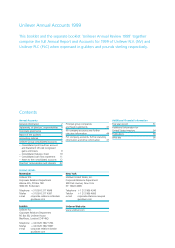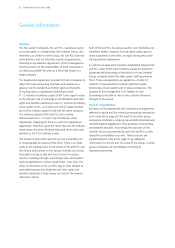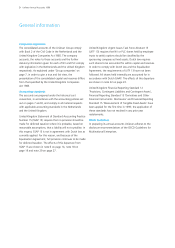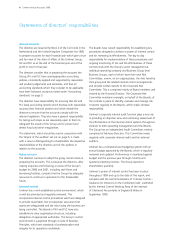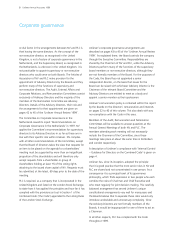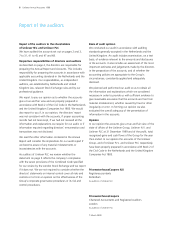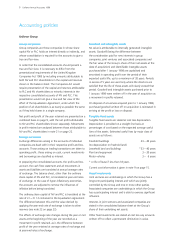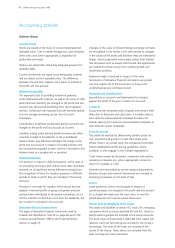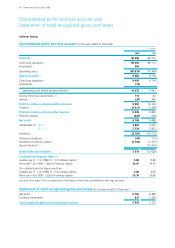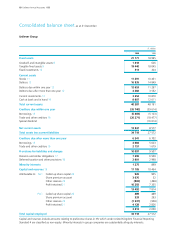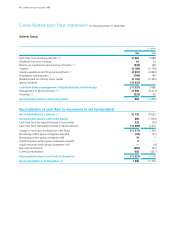Unilever 1999 Annual Report Download - page 7
Download and view the complete annual report
Please find page 7 of the 1999 Unilever annual report below. You can navigate through the pages in the report by either clicking on the pages listed below, or by using the keyword search tool below to find specific information within the annual report.Accounting policies
Unilever Group
Group companies
Group companies are those companies in whose share
capital NV or PLC holds an interest directly or indirectly, and
whose consolidation is required for the accounts to give a
true and fair view.
In order that the consolidated accounts should present a
true and fair view, it is necessary to differ from the
presentational requirements of the United Kingdom
Companies Act 1985 by including amounts attributable to
both NV and PLC shareholders in the capital and reserves
shown in the balance sheet. The Companies Act would
require presentation of the capital and reserves attributable
to PLC and NV shareholders as minority interests in the
respective consolidated accounts of NV and PLC. This
presentation would not give a true and fair view of the
effect of the Equalisation Agreement, under which the
position of all shareholders is as nearly as possible the same
as if they held shares in a single company.
Net profit and profit of the year retained are presented on a
combined basis on page 9, with the net profit attributable
to NV and PLC shareholders shown separately. Movements
in profit retained are analysed between those attributable to
NV and PLC shareholders in note 21 on page 22.
Foreign currencies
Exchange differences arising in the accounts of individual
companies are dealt with in their respective profit and loss
accounts. Those arising on trading transactions are taken to
operating profit; those arising on cash, current investments
and borrowings are classified as interest.
In preparing the consolidated accounts, the profit and loss
account, the cash flow statement and all movements in
assets and liabilities are translated at annual average rates
of exchange. The balance sheet, other than the ordinary
share capital of NV and PLC, is translated at year-end rates
of exchange. In the case of hyper-inflationary economies,
the accounts are adjusted to remove the influences of
inflation before being translated.
The ordinary share capital of NV and PLC is translated at the
rate of £1=Fl. 12 contained in the Equalisation Agreement.
The difference between this and the value derived by
applying the year-end rate of exchange is taken to other
reserves (see note 22 on page 22).
The effects of exchange rate changes during the year on net
assets at the beginning of the year are recorded as a
movement in profit retained, as is the difference between
profit of the year retained at average rates of exchange and
at year-end rates of exchange.
Goodwill and intangible assets
No value is attributable to internally generated intangible
assets. Goodwill (being the difference between
the consideration paid for new interests in group
companies, joint ventures and associated companies and
the fair value of the Group’s share of their net assets at the
date of acquisition) and identifiable intangible assets
purchased after 1 January 1998 are capitalised and
amortised in operating profit over the period of their
expected useful life, up to a maximum of 20 years. Periods
in excess of 5 years are used only where the directors are
satisfied that the life of these assets will clearly exceed that
period. Goodwill and intangible assets purchased prior to
1 January 1998 were written off in the year of acquisition as
a movement in profits retained.
On disposal of a business acquired prior to 1 January 1998,
purchased goodwill written off on acquisition is reinstated in
arriving at the profit or loss on disposal.
Tangible fixed assets
Tangible fixed assets are stated at cost less depreciation.
Depreciation is provided on a straight-line basis at
percentages of cost based on the expected average useful
lives of the assets. Estimated useful lives by major class of
assets are as follows:
Freehold buildings 33 – 40 years
(no depreciation on freehold land)
Leasehold land and buildings *33 – 40 years
Plant and equipment 3 – 20 years
Motor vehicles 3 – 6 years
* or life of lease if less than 33 years
Current cost information is given in note 9 on page 15.
Fixed investments
Joint ventures are undertakings in which the Group has a
long-term participating interest and which are jointly
controlled by the Group and one or more other parties.
Associated companies are undertakings in which the Group
has a participating interest and is able to exercise significant
influence.
Interests in joint ventures and associated companies are
stated in the consolidated balance sheet at the Group’s
share of their underlying net assets.
Other fixed investments are stated at cost less any amounts
written off to reflect a permanent diminution in value.
7Unilever Annual Accounts 1999

